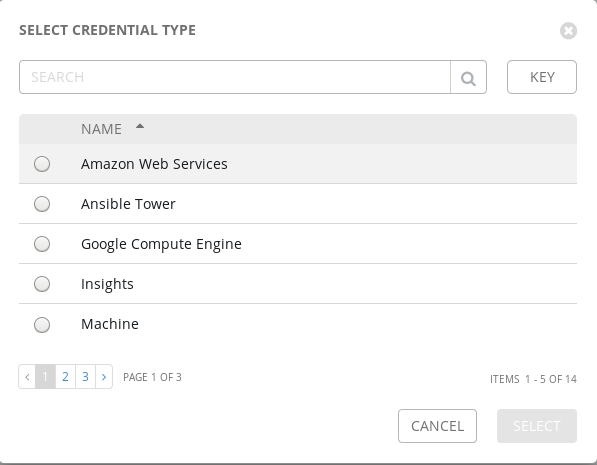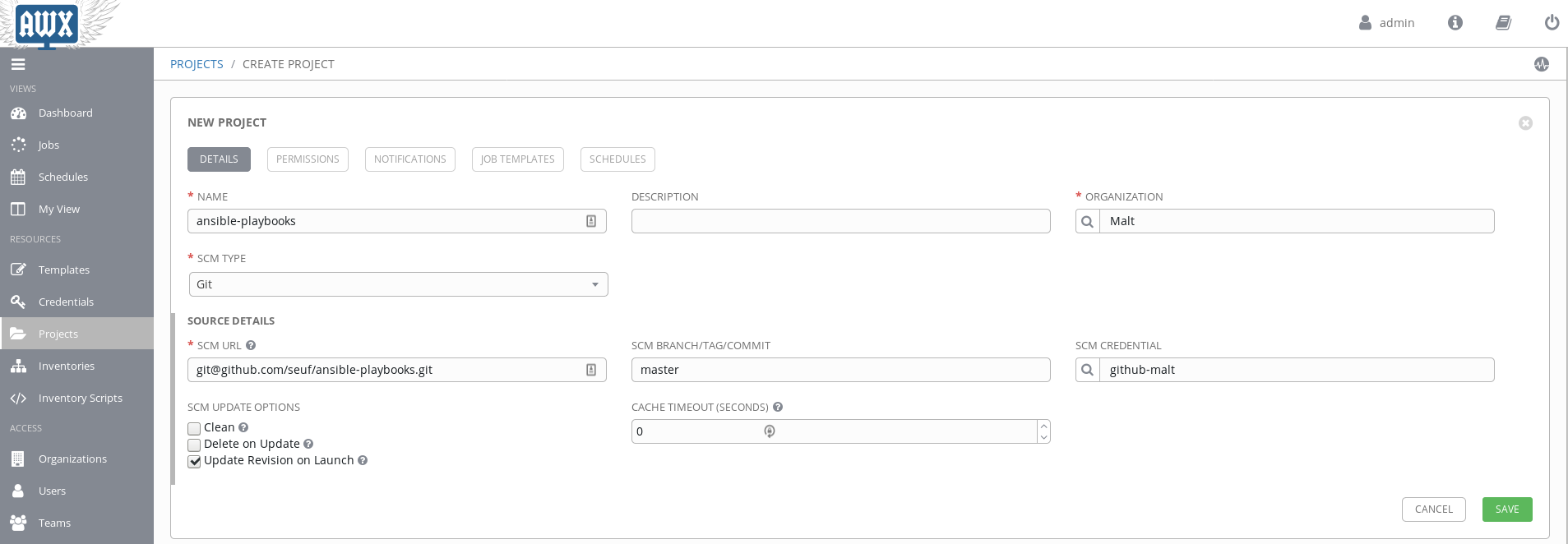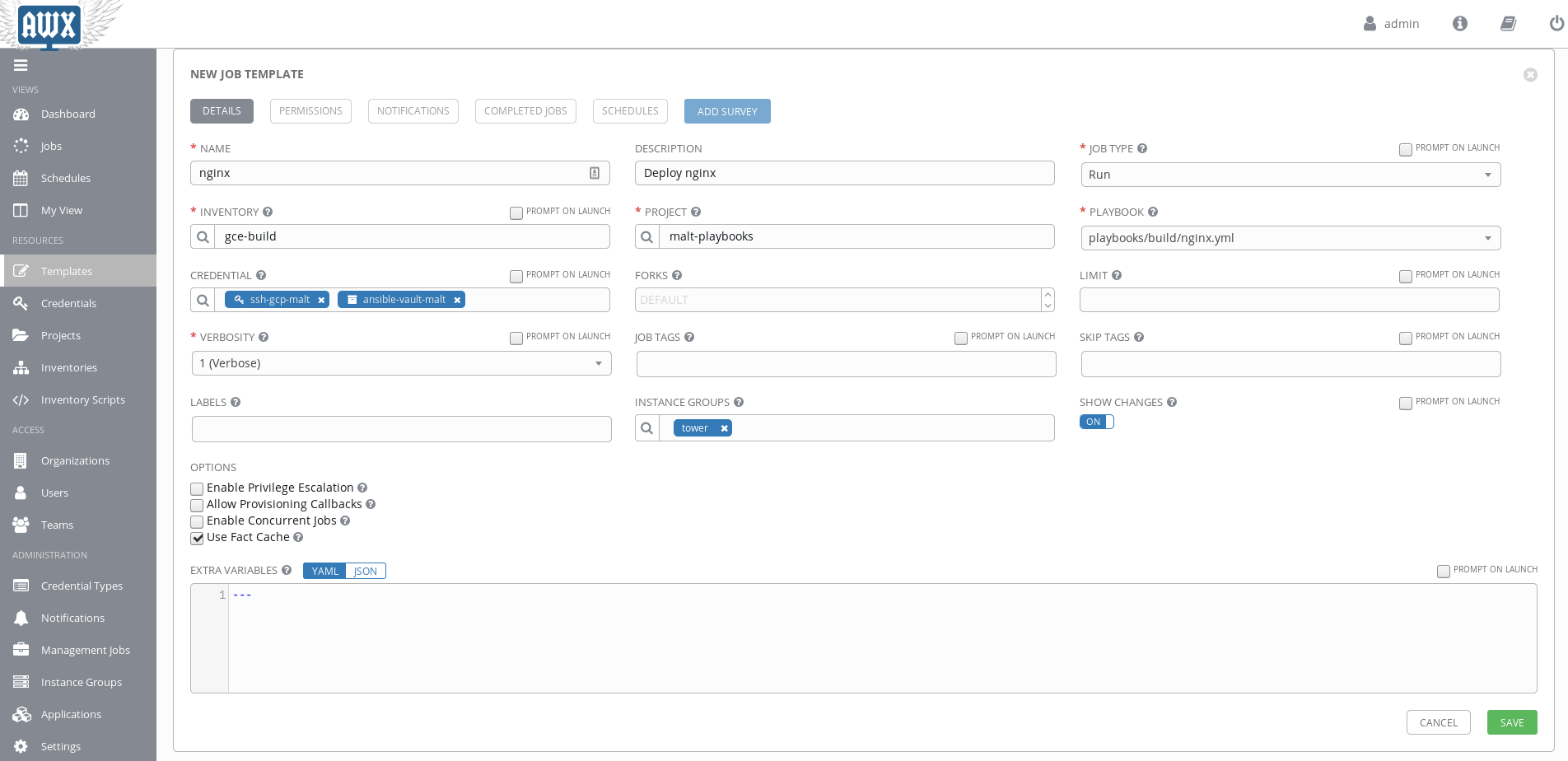
Ansible AWX in Kubernetes

AWX
Since one year now, Red Hat open sourced Tower as AWX, the Web UI to deploy with Ansible.
Awx allow you to manage all your Ansible projects, with inventories, encrypted credentials, playbooks, etc, in a great Web UI. For example, you can create in AWX multiple credentials which are encrypted into Awx database to store your :
- Ansible Vault password
- Google / Amazon / Azure cloud secret keys
- OpenStack tenant api key
- ssh deployment private key
- git ssh private key
- etc..

If all of theses credentials type are not sufficient, you can create your own custom credential type which can export environment variables or store secrets in a file when called.
Once you have imported your credentials into Awx you can create a project sourced from your git repository which contain your playbooks, requirements and roles

Then create inventories with dynamic sources from your cloud provider or your versioned source code. You can even create custom inventory scripts
Before running Ansible playbooks into Awx, you have to create templates, linked to your playbooks, where users can override variables or inventories before running the playbook.

Kubernetes

Here at Malt, we plan to migrate our infrastructure to google cloud, So why no use the one click available Kubernetes Cluster from gcloud ? All our current deployment are made with a mix of Terraform for machine provisioning, Bamboo for application building and of courses Ansible for deployments.
We still use Terraform to pop the k8s cluster because there is a google_container_cluster resource available. You just have to write a Terraform template with a Kubernetes cluster definition and attach a node pool to it. Finaly type « terraform apply » and after a coffee, your cluster will be ready.
Now it’s time to deploy Awx into our fresh Kubernetes cluster. I’ve looked for a helm chart already available, but the only one I’ve found is in a pull requests on the official helm chart repository. I’ve tried this but unfortunately it did’nt work for me.
Awx also provide a Kubernetes deployment playbook, but it use a one big pod with everything inside (rabbitmq, memcached, web and task). The default ressources requested by each pod were too high ; None of our small « testing » node in our cluster can validate the requirements. Also we prefer to use a pod per service.
So I’ve created an ansible playbook and role to deploy and configure awx in kubernetes. This playbook is a mix of helm chart deployment for Postgresql database and custom kubectl configuration templates. We use Traefik as the IngressController with Let’s encrypt certificate auto-generation.
Ansible AWX Playbook
Traefik helm chart

First we need to automatically generate Let’s Encrypt TLS certificates. Like I said before, I’m a big fan of Traefik. Traefik can be configured with Kubernetes as a source for new endpoints. Bonus : Traefik can be installed with a helm chart ! All I had to do is override some defaults values of the helm chart to configure Traefik properly.
rbac:
enabled: true
loadBalancerIP: "{{ kubernetes_loadbalancer_ip }}"
kubernetes:
ingressClass: traefik
dashboard:
enabled: true
domain: "traefik.{{ dns_zone }}"
ingress:
annotations:
kubernetes.io/ingress.class: "traefik"
ssl:
enabled: true
enforced: true
acme:
enabled: true
email: "{{ acme_email }}"
staging: false
domains:
enabled: true
domainsList:
- main: "*.{{ dns_zone }}"
- sans:
- "{{ dns_zone }}"
challengeType: dns-01
delayBeforeCheck: 10
dnsProvider:
name: dyn
dyn:
DYN_CUSTOMER_NAME: "{{ dyndns_customername }}"
DYN_USER_NAME: "{{ dyndns_username }}"
DYN_PASSWORD: "{{ dyndns_password }}"
metrics:
prometheus:
enabled: trueAs you see Traefik will ask Acme Let’s Encrypt to generate a wildcard certificate, thanks to the dns-01 challenge Type. The load balancer IP will also be set to a reserved IP which is already configured into to *.{{ dnz_zone }}in our DNS provider.
I’ve create a tiny ansible helm role who just template a jinja template for helm values and install / upgrade the chart :
- name: check if helm already installed
shell: helm ls | awk '{ print $1}'
register: helm_charts_installed
- name: Install helm charts
shell: echo {{ lookup('template', '../../templates/helm/' + item.name + '-values.yml.j2') | quote }} | helm install --namespace {{ item.namespace }} --name {{ item.name }} {{ item.chart }} -f -
loop: "{{ helm_charts }}"
when: item.name not in helm_charts_installed.stdout_lines
- name: Upgrade helm chart
shell: echo {{ lookup('template', '../../templates/helm/' + item.name + '-values.yml.j2') | quote }} | helm upgrade --namespace {{ item.namespace }} {{ item.name }} {{ item.chart }} -f -
loop: "{{ helm_charts }}"
when: item.name in helm_charts_installed.stdout_linesI can call this role with a helm_charts variable like this :
- role: helm
helm_charts:
- name: traefik
namespace: kube-system
chart: stable/traefikPostgresql helm chart

AWX need a Postgresql database to work. Helm is providing an up to date postgresql chart which can be installed like Traefik with my tiny ansible role helm. Here is my postgresql helm chart values template :
postgresqlUsername: awx
postgresqlPassword: "{{ awx_pg_password }}"
postgresqlDatabase: awx
persistence:
size: "{{ awx_pg_volume_capacity|default('8') }}Gi"
metrics:
enabled: trueAWX Kubernetes Deployment
Now we have a Kubernetes Ingress controller with a wildcard DNS, a wildcard TLS certificate and a Postgresql database installed, we can deploy the awx docker images into Kubernetes.
So here are the differents Kubernetes Deployments templates :
Rabbitmq :
apiVersion: extensions/v1beta1
kind: Deployment
metadata:
name: rabbitmq-deployement
namespace: awx
labels:
app: rabbitmq
spec:
replicas: 1
selector:
matchLabels:
app: rabbitmq
template:
metadata:
labels:
app: rabbitmq
spec:
containers:
- image: {{ awx_rabbitmq_image }}
name: rabbitmq
env:
- name: RABBITMQ_DEFAULT_VHOST
value: awx
- name: RABBITMQ_ERLANG_COOKIE
value: cookiemonster
livenessProbe:
exec:
command: ["rabbitmqctl", "status"]
initialDelaySeconds: 30
timeoutSeconds: 10
readinessProbe:
exec:
command: ["rabbitmqctl", "status"]
initialDelaySeconds: 10
timeoutSeconds: 10
---
apiVersion: v1
kind: Service
metadata:
name: rabbitmq-svc
namespace: awx
spec:
selector:
app: rabbitmq
ports:
- protocol: TCP
port: 5672
targetPort: 5672Memcached :
apiVersion: extensions/v1beta1
kind: Deployment
metadata:
name: memcached-deployement
namespace: awx
labels:
app: memcached
spec:
replicas: 1
selector:
matchLabels:
app: memcached
template:
metadata:
labels:
app: memcached
spec:
containers:
- image: memcached:alpine
name: memcached
---
kind: Service
apiVersion: v1
metadata:
name: memcached-svc
namespace: awx
spec:
selector:
app: memcached
ports:
- protocol: TCP
port: 11211
targetPort: 11211Secrets :
---
apiVersion: v1
kind: Secret
metadata:
namespace: awx
name: "awx-secrets"
type: Opaque
data:
admin_password: "{{ awx_admin_password | b64encode }}"
pg_password: "{{ awx_pg_password | b64encode }}"
rabbitmq_password: "{{ awx_rabbitmq_password | b64encode }}"
rabbitmq_erlang_cookie: "{{ awx_rabbitmq_erlang_cookie | b64encode }}"
confd_contents: "{{ lookup('template', 'credentials.py.j2') | b64encode }}"
credentials.py.j2
DATABASES = {
'default': {
'ATOMIC_REQUESTS': True,
'ENGINE': 'django.db.backends.postgresql',
'NAME': "{{ awx_pg_database }}",
'USER': "{{ awx_pg_username }}",
'PASSWORD': "{{ awx_pg_password }}",
'HOST': "{{ awx_pg_hostname|default('postgresql-awx-postgresql') }}",
'PORT': "{{ awx_pg_port }}",
}
}
BROKER_URL = 'amqp://{}:{}@{}:{}/{}'.format(
"guest",
"guest",
"rabbitmq-svc.awx",
"5672",
"awx")
CHANNEL_LAYERS = {
'default': {'BACKEND': 'asgi_amqp.AMQPChannelLayer',
'ROUTING': 'awx.main.routing.channel_routing',
'CONFIG': {'url': BROKER_URL}}
}
ConfigMap :
apiVersion: v1
kind: ConfigMap
metadata:
name: awx-config
namespace: awx
data:
secret_key: {{ awx_secret_key }}
awx_settings: |
import os
import socket
ADMINS = ()
AWX_PROOT_ENABLED = True
# Automatically deprovision pods that go offline
AWX_AUTO_DEPROVISION_INSTANCES = True
SYSTEM_TASK_ABS_CPU = {{ ((awx_task_cpu_request|int / 1000) * 4)|int }}
SYSTEM_TASK_ABS_MEM = {{ ((awx_task_mem_request|int * 1024) / 100)|int }}
#Autoprovisioning should replace this
CLUSTER_HOST_ID = socket.gethostname()
SYSTEM_UUID = '00000000-0000-0000-0000-000000000000'
SESSION_COOKIE_SECURE = False
CSRF_COOKIE_SECURE = False
REMOTE_HOST_HEADERS = ['HTTP_X_FORWARDED_FOR']
STATIC_ROOT = '/var/lib/awx/public/static'
PROJECTS_ROOT = '/var/lib/awx/projects'
JOBOUTPUT_ROOT = '/var/lib/awx/job_status'
SECRET_KEY = file('/etc/tower/SECRET_KEY', 'rb').read().strip()
ALLOWED_HOSTS = ['*']
INTERNAL_API_URL = 'http://127.0.0.1:8052'
SERVER_EMAIL = 'root@localhost'
DEFAULT_FROM_EMAIL = 'webmaster@localhost'
EMAIL_SUBJECT_PREFIX = '[AWX] '
EMAIL_HOST = 'localhost'
EMAIL_PORT = '25'
EMAIL_HOST_USER = ''
EMAIL_HOST_PASSWORD = ''
EMAIL_USE_TLS = False
LOGGING['handlers']['console'] = {
'()': 'logging.StreamHandler',
'level': 'DEBUG',
'formatter': 'simple',
}
LOGGING['loggers']['django.request']['handlers'] = ['console']
LOGGING['loggers']['rest_framework.request']['handlers'] = ['console']
LOGGING['loggers']['awx']['handlers'] = ['console']
LOGGING['loggers']['awx.main.commands.run_callback_receiver']['handlers'] = ['console']
LOGGING['loggers']['awx.main.commands.inventory_import']['handlers'] = ['console']
LOGGING['loggers']['awx.main.tasks']['handlers'] = ['console']
LOGGING['loggers']['awx.main.scheduler']['handlers'] = ['console']
LOGGING['loggers']['django_auth_ldap']['handlers'] = ['console']
LOGGING['loggers']['social']['handlers'] = ['console']
LOGGING['loggers']['system_tracking_migrations']['handlers'] = ['console']
LOGGING['loggers']['rbac_migrations']['handlers'] = ['console']
LOGGING['loggers']['awx.isolated.manager.playbooks']['handlers'] = ['console']
LOGGING['handlers']['callback_receiver'] = {'class': 'logging.NullHandler'}
LOGGING['handlers']['fact_receiver'] = {'class': 'logging.NullHandler'}
LOGGING['handlers']['task_system'] = {'class': 'logging.NullHandler'}
LOGGING['handlers']['tower_warnings'] = {'class': 'logging.NullHandler'}
LOGGING['handlers']['rbac_migrations'] = {'class': 'logging.NullHandler'}
LOGGING['handlers']['system_tracking_migrations'] = {'class': 'logging.NullHandler'}
LOGGING['handlers']['management_playbooks'] = {'class': 'logging.NullHandler'}
CACHES = {
'default': {
'BACKEND': 'django.core.cache.backends.memcached.MemcachedCache',
'LOCATION': '{}:{}'.format("memcached-svc", "11211")
},
'ephemeral': {
'BACKEND': 'django.core.cache.backends.locmem.LocMemCache',
},
}
USE_X_FORWARDED_PORT = True
And finally AWX pods, services and ingres :
---
apiVersion: extensions/v1beta1
kind: Deployment
metadata:
name: awx-deployement
namespace: awx
labels:
app: awx
spec:
replicas: 1
selector:
matchLabels:
app: awx
template:
metadata:
labels:
app: awx
spec:
containers:
- image: ansible/awx_web:latest
name: awx-web
imagePullPolicy: Always
env:
- name: DATABASE_USER
value: {{ awx_pg_username }}
- name: DATABASE_NAME
value: {{ awx_pg_database }}
- name: DATABASE_HOST
value: {{ awx_pg_hostname|default('postgresql-awx-postgresql') }}
- name: DATABASE_PORT
value: "{{ awx_pg_port|default('5432') }}"
- name: DATABASE_PASSWORD
valueFrom:
secretKeyRef:
name: "awx-secrets"
key: pg_password
- name: RABBITMQ_USER
value: guest
- name: RABBITMQ_PASSWORD
valueFrom:
secretKeyRef:
name: "awx-secrets"
key: rabbitmq_password
- name: RABBITMQ_HOST
value: rabbitmq-svc
- name: RABBITMQ_PORT
value: "5672"
- name: RABBITMQ_VHOST
value: awx
- name: MEMCACHED_HOST
value: "memcached-svc.awx"
- name: MEMCACHED_PORT
value: "11211"
ports:
- containerPort: 8052
volumeMounts:
- name: awx-application-config
mountPath: "/etc/tower"
readOnly: true
- name: "awx-confd"
mountPath: "/etc/tower/conf.d/"
readOnly: true
resources:
requests:
memory: "{{ awx_web_mem_request }}Gi"
cpu: "{{ awx_web_cpu_request }}m"
- image: ansible/awx_task:latest
name: awx-task
imagePullPolicy: Always
command:
- /usr/bin/launch_awx_task.sh
securityContext:
privileged: true
env:
# - name: AWX_SKIP_MIGRATIONS
# value: "1"
- name: DATABASE_USER
value: {{ awx_pg_username }}
- name: DATABASE_NAME
value: {{ awx_pg_database }}
- name: DATABASE_HOST
value: {{ awx_pg_hostname|default('postgresql-awx-postgresql') }}
- name: DATABASE_PORT
value: "{{ awx_pg_port|default('5432') }}"
- name: DATABASE_PASSWORD
valueFrom:
secretKeyRef:
name: "awx-secrets"
key: pg_password
- name: AWX_ADMIN_USER
value: admin
- name: AWX_ADMIN_PASSWORD
valueFrom:
secretKeyRef:
name: "awx-secrets"
key: admin_password
- name: RABBITMQ_USER
value: guest
- name: RABBITMQ_PASSWORD
valueFrom:
secretKeyRef:
name: "awx-secrets"
key: rabbitmq_password
- name: RABBITMQ_HOST
value: rabbitmq-svc
- name: RABBITMQ_PORT
value: "5672"
- name: RABBITMQ_VHOST
value: awx
- name: MEMCACHED_HOST
value: "memcached-svc.awx"
- name: MEMCACHED_PORT
value: "11211"
volumeMounts:
- name: awx-application-config
mountPath: "/etc/tower"
readOnly: true
- name: "awx-confd"
mountPath: "/etc/tower/conf.d/"
readOnly: true
resources:
requests:
memory: "{{ awx_web_mem_request }}Gi"
cpu: "{{ awx_web_cpu_request }}m"
volumes:
- name: awx-application-config
configMap:
name: awx-config
items:
- key: awx_settings
path: settings.py
- key: secret_key
path: SECRET_KEY
- name: "awx-confd"
secret:
secretName: "awx-secrets"
items:
- key: confd_contents
path: 'secrets.py'
---
kind: Service
apiVersion: v1
metadata:
name: awx-svc
namespace: awx
spec:
selector:
app: awx
ports:
- name: http
protocol: TCP
port: 80
targetPort: 8052
---
apiVersion: extensions/v1beta1
kind: Ingress
metadata:
name: awx-ing
namespace: awx
annotations:
kubernetes.io/ingress.class: traefik
spec:
rules:
- host: awx.{{ dns_zone }}
http:
paths:
- path: /
backend:
serviceName: awx-svc
servicePort: 80Because awx_web and awx_tasks use an id based on the hostname to synchronise their tasks, (awx-manage provision_instance –hostname=$(hostname) ), I had to put the two docker images in the same pod.
Also The configMap templates came from the awx installer role.
All theses templates are rendered and sent to kubernetes with a simple task :
- name: Apply Deployment
shell: |
echo {{ lookup('template', item + '.yml.j2') | quote }} | kubectl apply -f -
loop:
- rabbitmq
- memcached
- secrets
- configMap
- awx
no_log: trueAwx configuration
Now we have Awx running into our Kubernetes cluster, it’s time to configure it, with ansible of course.
The Awx role use the uri module to confifure Awx via the API.
configure.yml
---
- name: configure authentication
uri:
method: PUT
url: "{{ awx_url }}/api/v2/settings/authentication/"
user: admin
password: "{{ awx_admin_password }}"
force_basic_auth: yes
body_format: json
body:
SESSION_COOKIE_AGE: 1800
SESSIONS_PER_USER: -1
AUTH_BASIC_ENABLED: true
OAUTH2_PROVIDER:
ACCESS_TOKEN_EXPIRE_SECONDS: 31536000000
AUTHORIZATION_CODE_EXPIRE_SECONDS: 600
ALLOW_OAUTH2_FOR_EXTERNAL_USERS: true
SOCIAL_AUTH_ORGANIZATION_MAP: null
SOCIAL_AUTH_TEAM_MAP: null
SOCIAL_AUTH_USER_FIELDS: null
- name: configure basic settings
uri:
method: PATCH
url: "{{ awx_url }}/api/v2/settings/all/"
user: admin
password: "{{ awx_admin_password }}"
force_basic_auth: yes
body_format: json
body:
ALLOW_OAUTH2_FOR_EXTERNAL_USERS: true
AUTH_BASIC_ENABLED: true
MANAGE_ORGANIZATION_AUTH: true
ORG_ADMINS_CAN_SEE_ALL_USERS: true
SESSION_COOKIE_AGE: 86400
SESSION_PER_USER: -1
TOWER_ADMIN_ALERTS: true
TOWER_URL_BASE: "{{ awx_url }}"
- include_tasks: configure_item.yml
with_items: "{{ awx_configuration }}"
configure_item.yml :
---
- name: get {{ item.config_name }} credential
uri:
method: GET
url: "{{ awx_url }}/api/v2/{{ item.config_type }}/?name={{ item.config_name }}"
user: admin
password: "{{ awx_admin_password }}"
force_basic_auth: yes
register: awx_config_register
- set_fact:
config_body: "{{ item.config_body }}"
- name: fetch {{ item.config_name }} dependencies
uri:
method: GET
url: "{{ awx_url }}/api/v2/{{ dep.type }}/?name={{ dep.name }}"
user: admin
password: "{{ awx_admin_password }}"
force_basic_auth: yes
register: awx_config_dependencies_register
when: item.config_dependencies is defined and awx_config_register.json.count == 0
loop: "{{ item.config_dependencies }}"
loop_control:
loop_var: dep
- name: set {{ item.config_name }} {{ item.config_type }} configuration body with dependencies
set_fact:
config_body: "{{ config_body | combine({res.dep.param: res.json.results[0].id}) }}"
loop: "{{ awx_config_dependencies_register.results }}"
loop_control:
loop_var: res
when: item.config_dependencies is defined and awx_config_register.json.count == 0
- name: configure {{ item.config_name }} {{ item.config_type }}
uri:
method: POST
url: "{{ awx_url }}/api/v2/{{ item.config_type }}/"
user: admin
password: "{{ awx_admin_password }}"
force_basic_auth: yes
body_format: json
status_code:
- 200
- 201
body: "{{ config_body }}"
when: awx_config_register.json.count == 0
With this tasks I can use a unique variable awx_configuration
which contain all my projects, repos, inventories, etc..
awx_configuration:
## credential git
- config_name: git-cred
config_type: credentials
config_body:
body:
name: "git-cred"
description: ""
organization: 1
credential_type: 2 #git
inputs:
username: "malt"
ssh_key_data: "{{ awx_ssh_private_key }}"
## credential ssh machine
- config_name: ssh-cred
config_type: credentials
config_body:
name: "ssh-cred"
description: ""
organization: 1
credential_type: 1 #machine
inputs:
username: "deploy"
ssh_key_data: "{{ awx_gcp_ssh_private_key }}"
ssh_key_unlock: "{{ awx_gcp_ssh_private_key_password }}"
## credential ansible vault
- config_name: ansible-vault-cred
config_type: credentials
config_body:
name: "ansible-vault-cred"
description: ""
organization: 1
credential_type: 3 #vault
inputs:
vault_password: "{{ awx_ansible_vault_password }}"
## credential gcloud inventory
- config_name: gce-cred
config_type: credentials
config_body:
name: gce-cred
organization: 1
credential_type: 10 # gce
inputs:
project: "default"
username: "ansible@account.iam.gserviceaccount.com"
ssh_key_data: "{{ awx_gcloud_private_key }}"
## projects
- config_name: playbooks
config_type: projects
config_dependencies:
- type: credentials
param: credential
name: git-cred
config_body:
name: playbooks
description: ""
scm_type: git
scm_url: git@git.malt.fr/ansible/playbooks
scm_branch: master
scm_clean: false
scm_delete_on_update: false
timeout: 0
organization: 1
scm_update_on_launch: true
scm_update_cache_timeout: 0
custom_virtualenv: null
## notification_templates
- config_name: slack
config_type: notification_templates
config_body:
name: "slack"
description: ""
organization: 1
notification_type: "slack"
notification_configuration:
channels:
- "#3-ops-ansible"
use_ssl: false
token: "{{ awx_slack_bot_token }}"
use_tls: false
## inventories
- config_name: gce-inventory
config_type: inventories
config_dependencies:
- type: credentials
param: credential
name: ansible-vault-cred
config_body:
name: gce-inventory
organization: 1
## inventory sources
- config_name: inventory-gce
config_type: inventory_sources
config_dependencies:
- type: credentials
param: credential
name: gce-cred
- type: inventories
param: inventory
name: gce-inventory
config_body:
name: "inventory-gce"
source: "gce"
source_regions: "all"
timeout: 0
verbosity: 1
update_on_launch: true
update_cache_timeout: 0
update_on_project_update: false
- config_name: inventory-static
config_type: inventory_sources
config_dependencies:
- type: inventories
param: inventory
name: gce-inventory
- type: projects
param: source_project
name: playbooks
config_body:
credential:
name: "inventory-static"
source: "scm"
source_path: "inventories"
source_regions: ""
source_vars:
overwrite_vars: true
verbosity: 1
update_on_launch: false
update_cache_timeout: 0
update_on_project_update: true
## jobs templates
- config_name: deploy
config_type: job_templates
config_dependencies:
- type: projects
param: project
name: playbooks
- type: credentials
param: credential
name: ssh-cred
- type: credentials
param: vault_credential
name: ansible-vault-cred
- type: inventories
param: inventory
name: gce-inventory
config_body:
name: "deploy"
job_type: "run"
playbook: "playbooks/deploy.yml"
verbosity: 1
extra_vars: "---\ndebug: true"
diff_mode: true
ask_variables_on_launch: trueNow everything is configured, I can login with the admin password I’ve set, and all my inventories / credentials / projects / etc.. are already set !
All I have to do is click on the rocket button to deploy all the other stuffs, and I will receive a Slack notification when the job is done !
I have a question about the first yaml file. This is my first time attempting to configure traefik in kubernetes, and curious what loadBalancerIP: « {{ kubernetes_loadbalancer_ip }} » is referring to exactly?
What are the pre-requisites for attempting this? I have a k8s cluster built out already with ceph storage, and only a few services running. I just really want to install AWX the way that you did.
the {{ kubernetes_loadbalancer_ip }} refer the global ip I’ve reserver with gcloud